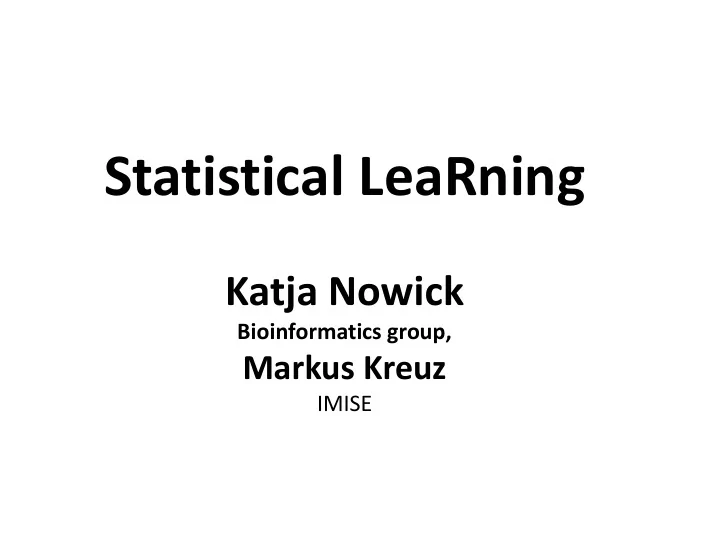

Statistical LeaRning Katja Nowick Bioinformatics group, Markus Kreuz IMISE
What is R? • Programming/scripting language • Comprehensive statistical environment • Strength : statistical data analysis + graphical display
Why use R? • It's free ! • Runs on a variety of platforms including Windows, Unix and MacOS. • Complicated bioinformatics analyses made easy by a huge collection of packages in Bioconductor • Potential to implement automated workflows • Big datasets • Advanced statistical routines • State-of-the-art graphics capabilities
How to obtain and install R? • R can be downloaded from the Comprehensive R Archive Network (CRAN): http://cran.r- project.org/ • Installation instructions depend on your operating system and should be accessible from the R download page for you operating system. • For our course, R is already installed We use R-studio as programming environment
750 packages in Bioconductor
Binding site detection Finding binding sites for a transcription factor in the promoter of a gene With only 8 lines of code: query(MotifDb, "DAL80") pfm.dal80.jaspar = query(MotifDb, "DAL80")[[1]] seqLogo(pfm.dal80.jaspar) dal1 = "YIR027C" chromosomal.loc = transcriptsBy(TxDb.Scerevisiae.UCSC.sacCer3.sgdGene, by = "gene")[dal1] promoter.dal1 = getPromoterSeq(chromosomal.loc, Scerevisiae, upstream=1000, downstream=0) pcm.dal80.jaspar = round(100 * pfm.dal80.jaspar) matchPWM(pcm.dal80.jaspar, unlist(promoter.dal1)[[1]], "90%")
Quality assessment of NGS data From a directory of FastQ files to a full quality report: With 6 lines of code: files = list.files("fastq", full=TRUE) names(files) = sub(".fastq", "", basename(files)) qas = lapply(seq_along(files), function(i, files) qa(readFastq(files[i]), names(files)[i]), files) qa <- do.call(rbind, qas) save(qa, file=file.path("output", "qa.rda")) browseURL(report(qa))
Differential gene expression From mapped and counted RNA-Seq data to differentially expressed genes Hcounts=read.table("segemehl.hg19.readCount", head=T, sep="\t", quote="", stringsAsFactor=FALSE, row.names="id") Ccounts=read.table("segemehl.panTro3.readCount", head=T, sep="\t", quote="", stringsAsFactor=FALSE, row.names="id") counts=cbind(Hcounts, Ccounts) colnames(counts)=c("H1", "H2", "H3", "C1", "C2", "C3") groups=c(0,0,0,1,1,1) counts_DESeq_obj=newCountDataSet(counts, groups) counts_DESeq_obj=estimateSizeFactors(counts_DESeq_obj) counts_DESeq_obj=estimateDispersions(counts_DESeq_obj) DESeq_DEgenes=nbinomTest(counts_DESeq_obj, "0", "1") plot(DESeq_DEgenes$baseMean,DESeq_DEgenes$log2FoldChange,log="x", pch=20, cex=.1,col=ifelse(DESeq_DEgenes$padj < 0.05, "red", "black" ) ) signDESeq_DEgenes=DESeq_DEgenes[DESeq_DEgenes$padj<0.05,] head(signDESeq_DEgenes[order(signDESeq_DEgenes$padj),])
Finding help • R mailing lists : https://stat.ethz.ch/mailman/listinfo/ • Manuals and FAQs : http://www.r-project.org/ • Selected tutorials : – http://www.math.ilstu.edu/dhkim/Rstuff/Rtutor.html – http://www.statmethods.net/index.html – http://faculty.ucr.edu/~tgirke/Documents/R_BioCond/R_Bi oCondManual.html
Goals for the next 5 x 5 hours Dec 3 rd : Introduction to R Dec 10 th : Statistics and Graphics Dec 17 th : A small programming project Jan 14 th : Analysis of gene expression data Jan 21 st : Clustering and Gene Ontology
Goals for the first 5 hours R-Studio • R as a calculator (interactive R) • Variables: numeric, character, arrays, vectors, matrices • Loops • Apply • Conditional executions (if-else-statements) • Write your own functions • Multiple exercises in between
Optional for today If you are already familiar with R • Find all genes in the human genome that have a binding site for the transcription factor EGR1: - Search for the EGR1 binding sites within the promoters of the human genes in a window from 5000 bp upstream to 2000 bp downstream of the transcription start site • Which genes are targeted by EGR1 only in humans? - Search for EGR1 binding sites within the chimpanzee, orangutan, and rhesus macaque genome to answer this question - What are the genes associated with the human specific binding sites? • Which genes are not targeted by EGR1 in humans? - Find out which binding sites are in the other three primate genomes but not in the human genome - Which genes are associated with the human specifically lost binding sites?
Goals for second 5 hours R packages • Help pages • Some more on functions • Graphics • Statistical tests • Multiple exercises in between
Recommend
More recommend